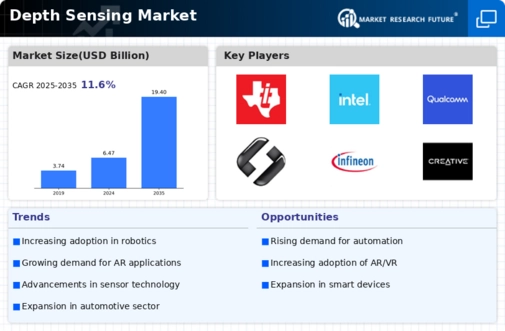Leading market players are investing heavily in research and development to expand their product lines, which will help the depth sensing market grow even more. Market participants are also undertaking numerous strategic activities to expand their global footprint, with important market developments including new product launches, mergers and acquisitions, higher investments, contractual agreements, and collaboration with other organizations. To expand and survive in a more competitive and rising market climate, the depth sensing industry must offer cost-effective items.
Manufacturing locally to minimize operational costs is one of the key business tactics manufacturers use in the global depth sensing industry to benefit clients and increase the market sector. Major players in the depth sensing market, including Texas Instruments (US), Intel (US), Qualcomm (US), Stereolabs (US), Infineon Technologies (Germany), and others, are attempting to increase market demand by investing in research and development operations.
STMicroelectronics NV is a manufacturer and provider of semiconductors. The firm develops and markets a range of products, such as discrete and standard commodity components, application-specific standard and integrated circuits, and custom devices and semi-custom devices. It also produces and sells power modules, switches, clocks, data converters, automotive ADAS devices, imaging and photonics solutions, silicon chips and smartcards. STM uses numerous chip fabrication technologies, such as advanced FD-SOI, CMOS, embedded non-volatile memories, RF-SOI, optical sensing, analog and MEMS, mixed-signal, and smart power processes. It serves consumers in various markets, such as industrial, automotive, personal electronics, computers, communications equipment, and peripherals.
In February 2022, STMicroelectronics launched its new series of high-resolution Time-of-Flight sensors to provide advanced 3D depth imaging for smartphones and other devices. With the launch of the VD55H1 3D depth sensor, ST aims to strengthen its market position in the Time-of-Flight (ToF) product market and complement its full range of depth sensing technologies.
Analog Devices Inc designs, manufactures and markets analog, mixed-signal, and digital signal-processing integrated circuits (ICs). It serves instrumentation, aerospace and defense, building technology, consumer, communications, healthcare, energy, security and surveillance, and automotive industries. Analog Devices markets products through a direct sales force, independent sales representatives, third-party distributors, and through the website. The company operates manufacturing centers in the US, the Philippines, Ireland, Thailand and Malaysia. In June 2022, Analogue Devices, Inc. launched the first high-resolution, commercial-grade indirect Time-of-Flight module for 3D depth sensing and vision systems.
The recent ADTF3175 module provides quite precise +/-3mm iToF technology for machine concept applications from industrial automation to logistics and increased reality, permitting cameras and sensors to sense 3D space in one-megapixel resolution.





















